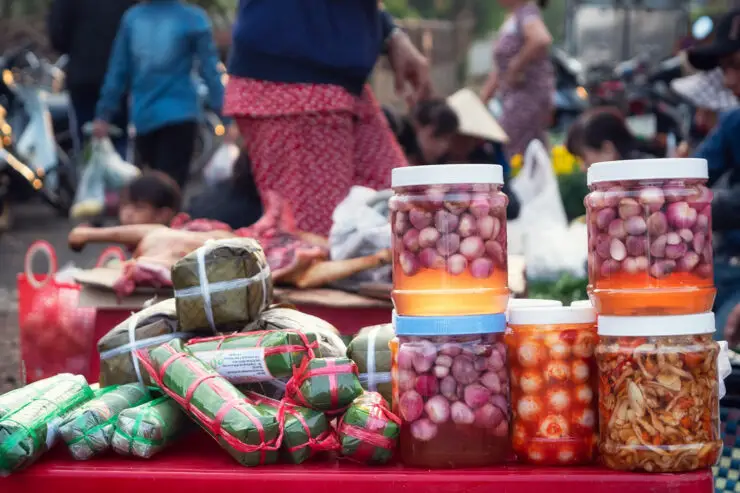As an Amazon Associate I earn from qualifying purchases. Please read the disclaimer for more info.
Vietnamese New Year Food (Tet Food) is served during the Vietnamese Lunar New Year, also known as Tet, which is short for Tết Nguyên Đán. Tet is the biggest and most important holiday in Vietnam.
The Vietnamese family will clean their homes, buy new clothes, visit family and friends, take part in ancestor worshipping, exchange gifts, and prepare special food for Tet to welcome in the New Year.
Tet food, such as Banh Chung and Banh Tet, are traditional Vietnamese foods that are thought to bring good luck and prosperity in the coming year.
Here are 13 of the most popular Vietnamese New Year dishes and what they are thought to represent:
Vietnamese New Year Food – 13 Celebration Dishes
Table of Contents
- Vietnamese New Year Food – 13 Celebration Dishes
- Bánh Tét (Tet Sticky Rice Cake – Banh Tet)
- Bánh Chưng (Sticky Rice Dumplings – Banh Chung)
- Chả Giò (Southern Vietnam) Nem Rán (Northern Vietnam) – Fried Spring Rolls
- Bò Kho (Vietnamese Beef Stew)
- Thịt Kho Trứng (Caramelized pork and eggs)
- Cháo Gà (Chicken Rice Soup)
- Mứt (Candied Fruits)
- Mâm Ngũ Quả (Five fruit tray)
- Gà Luộc (Boiled Chicken)
- Hạt Dưa (Melon Seeds)
- Canh Bóng
- Dưa Hành (Pickled Onions)
- Chả lụa (Vietnamese Sausage)
- Summary of Vietnamese New Year Food (Tet Food)
- FAQs
Bánh Tét (Tet Sticky Rice Cake – Banh Tet)
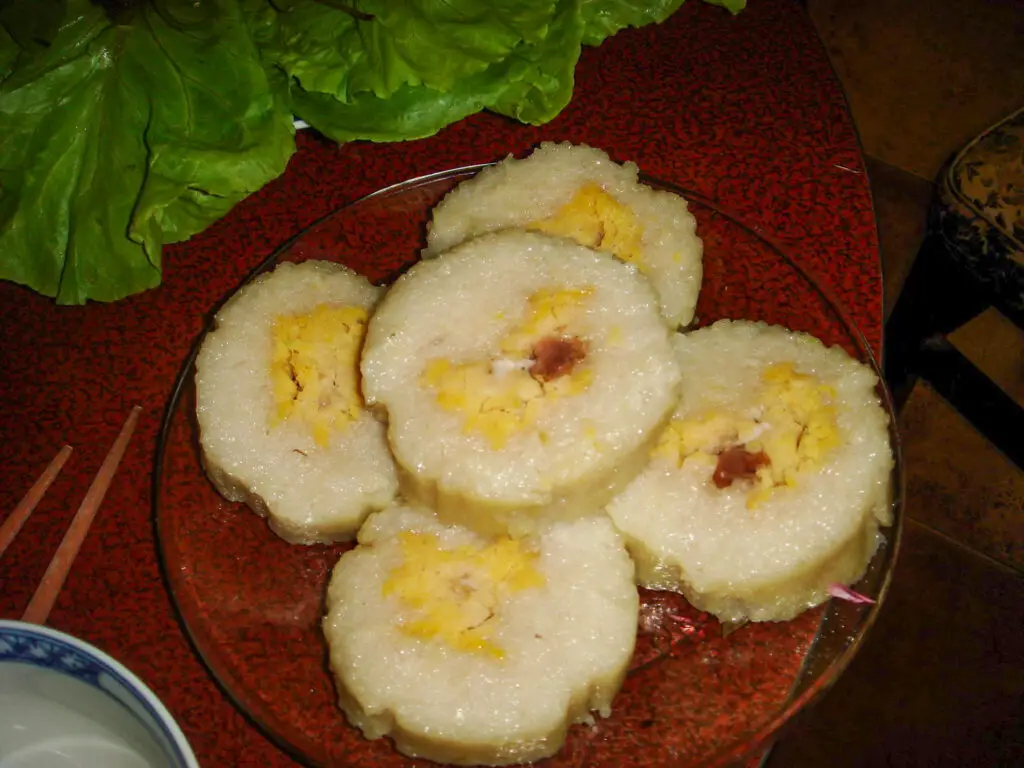
Banh Tet is a traditional Tet food that is often served during the Lunar New Year. The dish is made with glutinous rice, pork, mung beans, and black-eyed peas, and it is typically wrapped in banana leaves before being steamed.
Banh Tet is often considered to be a symbol of good luck, as its cylindrical shape resembles a gold ingot. The dish can be served plain or with a variety of different toppings, such as green onions, pickled vegetables, or fish sauce.
Bánh Chưng (Sticky Rice Dumplings – Banh Chung)
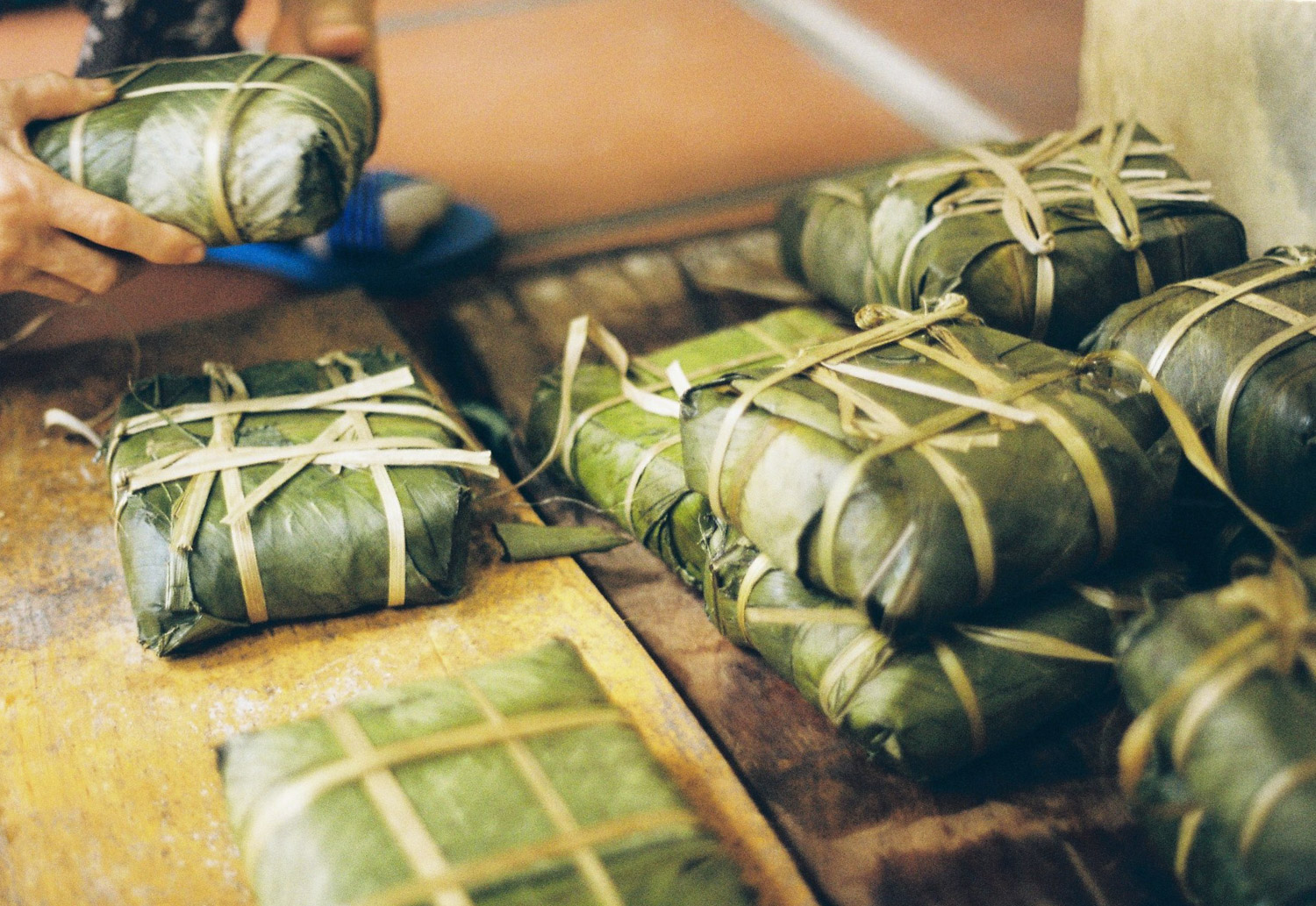
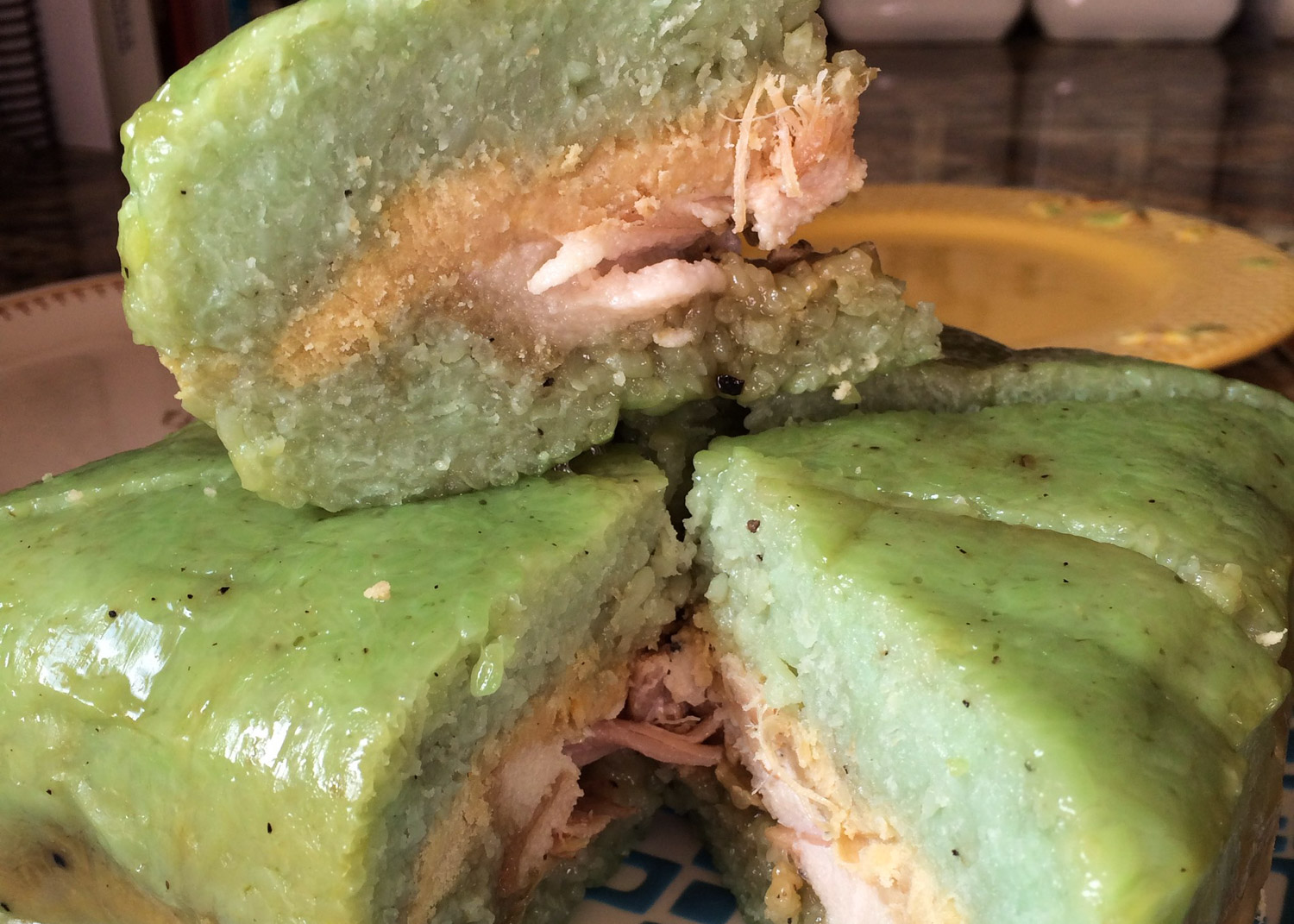
Another traditional Vietnamese New Year food, these dumplings are made of sticky rice, mung beans, and pork, and are wrapped in banana leaves before being boiled or steamed.
The green Banh Chung are presented in a square shape, and are a popular Vietnamese food
Banh Chung is said to represent the Earth, with the rice representing the land, the mung beans representing the people, and the pork representing wealth. Banh chung is often served with pickled vegetables and a dipping sauce made from fish sauce, lime juice, and chili peppers.
Cooking Resources: 11 Best Vietnamese Cookbooks to Add to Your Kitchen
Chả Giò (Southern Vietnam) Nem Rán (Northern Vietnam) – Fried Spring Rolls
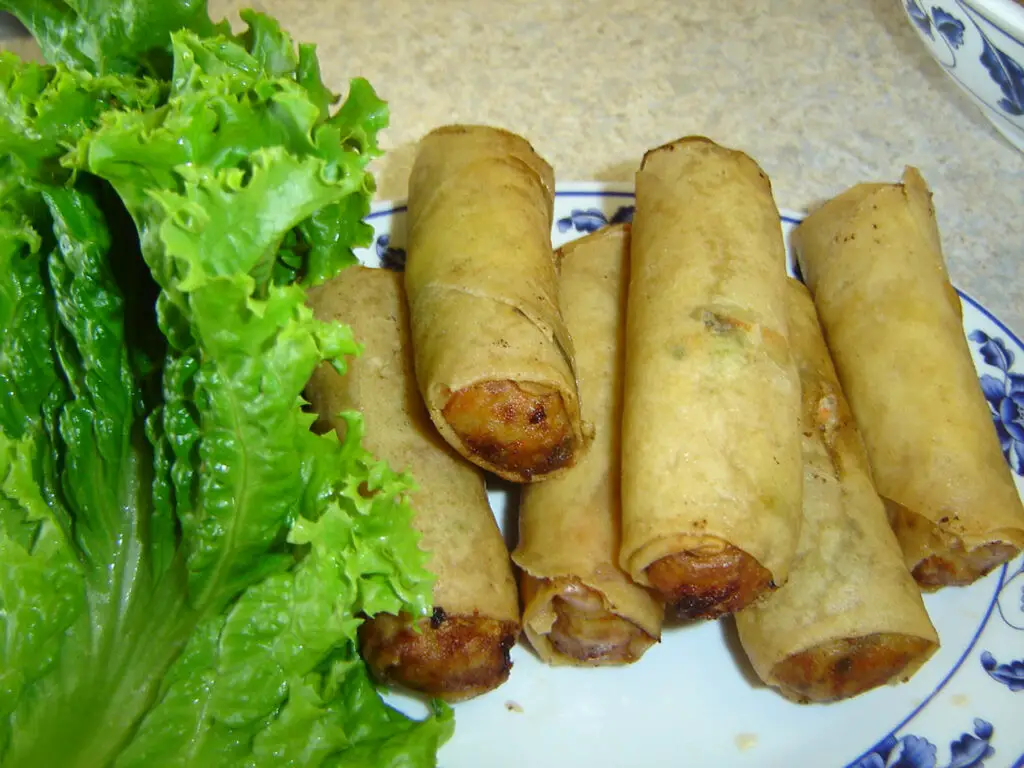
These crispy fried rolls, cha gio and nem ran, are filled with a variety of fillings including minced pork, shrimp, noodles, and vegetables. They are often served as an appetizer or a snack during Lunar New Year celebrations.
The dish is considered lucky because it is thought to resemble gold ingots, which were once used as currency in Vietnam.
Bò Kho (Vietnamese Beef Stew)
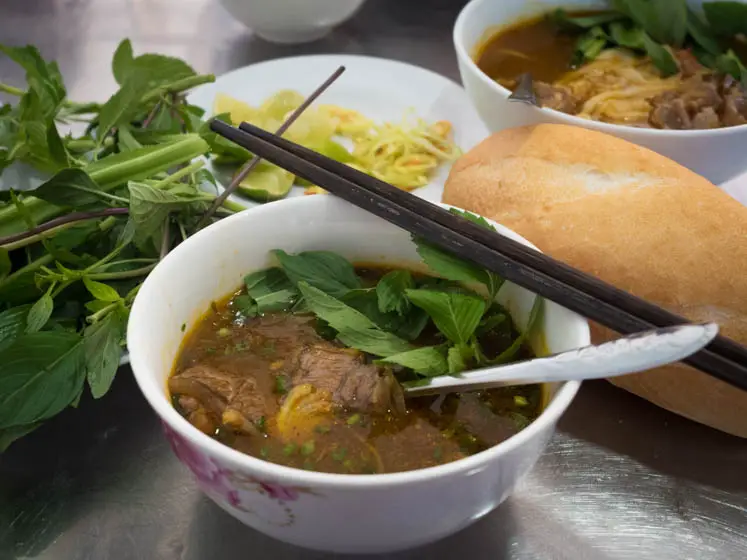
A hearty and filling stew made with beef, carrots, daikon radish, and lemongrass. It is traditionally cooked in a clay pot and served with rice or bread.
Bo Kho is generally served with rice noodles or fresh bread and a side of fresh herbs. The rich flavors of the stew represent the abundance of the coming year, while the noodles represent longevity.
Thịt Kho Trứng (Caramelized pork and eggs)
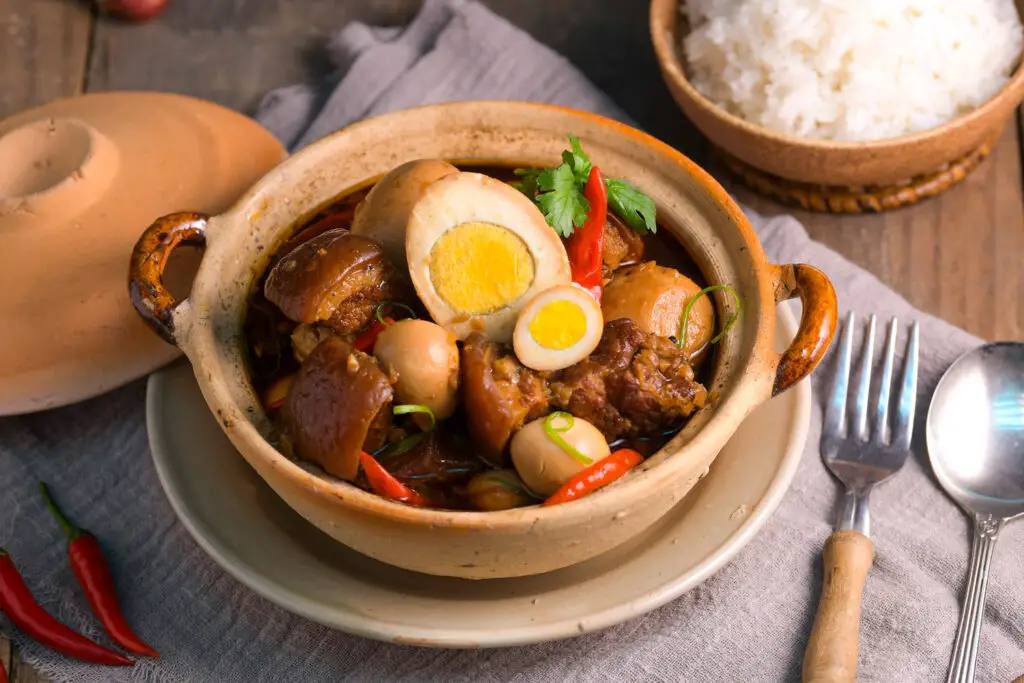
Thit Kho Trung is a popular Tet food served during the Vietnamese Lunar New Year.
The dish consists of braised eggs, pork, and vegetables in a rich sauce. The name of the dish comes from the fact that the eggs are often cooked until they are firm and have a brown, crusty appearance.
This represents the earth, while the braised pork and vegetables represent the different elements of nature. Thit Kho Trung is traditionally served with steamed rice and pickled vegetables, making it a hearty and filling meal.
Cháo Gà (Chicken Rice Soup)

Chao ga is a warming food for Tet made from steamed chicken and rice , and is a simple yet delicious dish.
The dish is thought to represent good luck and fortune, as the white color of the rice symbolizes purity and new beginnings.
Chao ga is usually made with chicken thighs or drumsticks, as the dark meat is more flavorful. The rice is typically steamed with garlic, ginger, and scallions, and then topped with a variety of sauces and herbs.
Once the dish is cooked, it is typically served with pickled vegetables and fresh lime wedges.
Mứt (Candied Fruits)
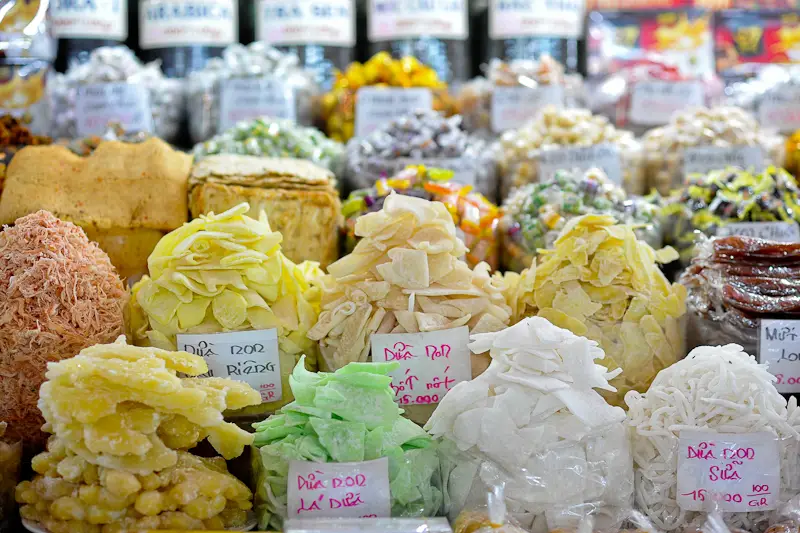
Mut are candied fruits that are often served during Vietnamese New Year. The word mut means “to dip”, and the fruits are dipped in a sugar syrup before being rolled in coconut flakes.
These candied fruits can be made with a variety of different fruits, but the most common ones are mangoes, coconuts, star fruit and oranges. The sweetness of the candied fruit is meant to represent the hope for a sweet new year, while the coconut flakes represent the snow-capped mountains of Vietnam.
In addition to being served as part of a traditional Tet feast, mut are also given as gifts to family and friends. They are often packaged in lacquer boxes or baskets, which symbolize good luck and prosperity.
Mâm Ngũ Quả (Five fruit tray)
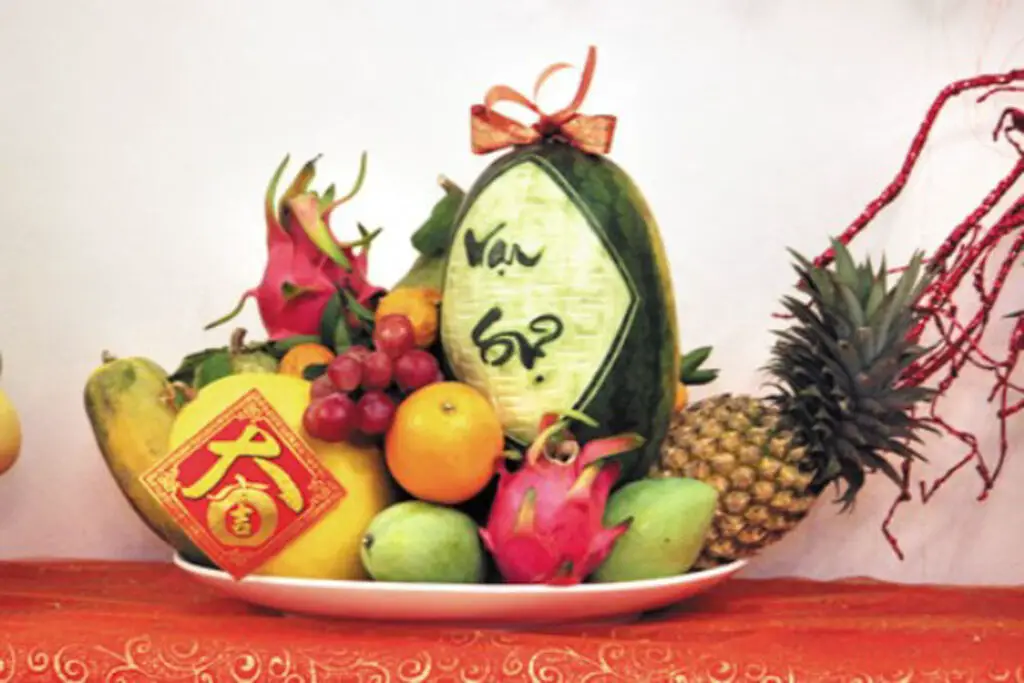
The Five Fruit Tray is a traditional dish served during the Vietnamese Lunar New Year, or Tet.
The tray is decorated with five different kinds of fruit, which represent the five elements of nature: metal, wood, water, fire, and earth. The dish is meant to bring good luck and fortune in the new year.
The fruits on the tray are also believed to have positive symbolic meaning. For example, oranges represent luck and wealth, while bananas represent fertility.
The Five Fruit Tray is a colorful and festive way to celebrate the start of the new year. Not only does it look beautiful, but it also symbolizes hope for a prosperous and happy year ahead.
Gà Luộc (Boiled Chicken)
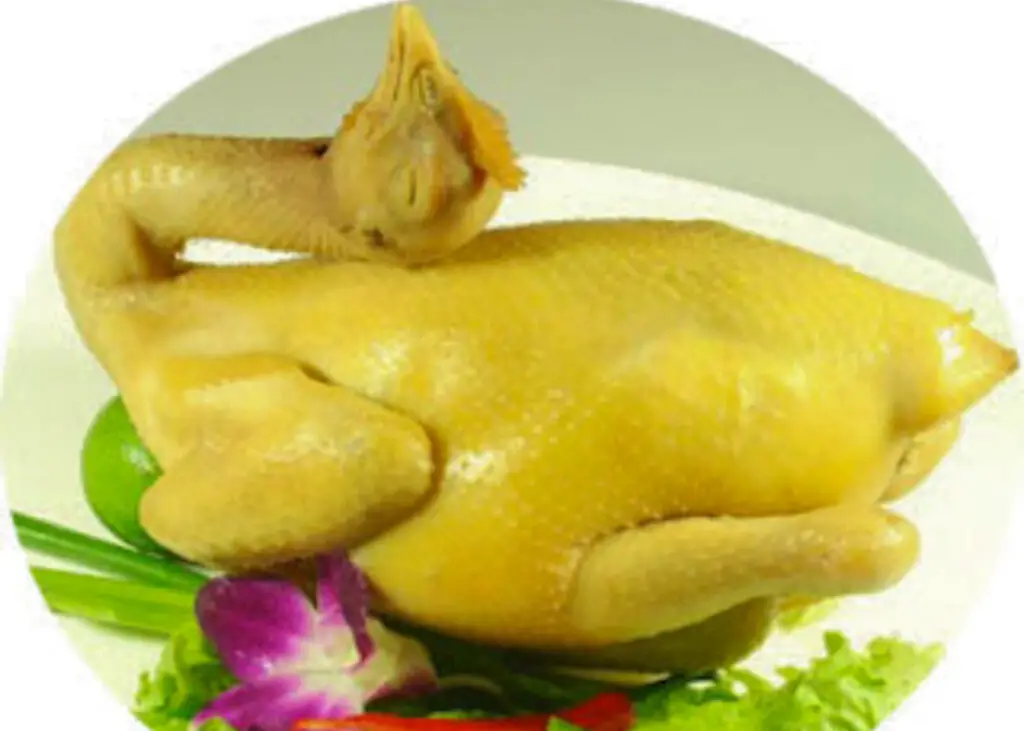
A popular food during the Tet holiday is gà luộc or boiled chicken. The chicken is usually simmered in a mixture of water, ginger, and spices until it is cooked through.
The dish is often served with a dipping sauce made from fish sauce, lemon juice, and chili peppers.
Boiled chicken is symbolic of good luck and abundance. The white meat represents purity and healing, while the red skin symbolizes good fortune and happiness.
Tet is a time to celebrate new beginnings, and boiled chicken is a reminder that we all have the potential for a fresh start. By enjoying this dish, we can set our intention for a prosperous and joyful year ahead.
Hạt Dưa (Melon Seeds)
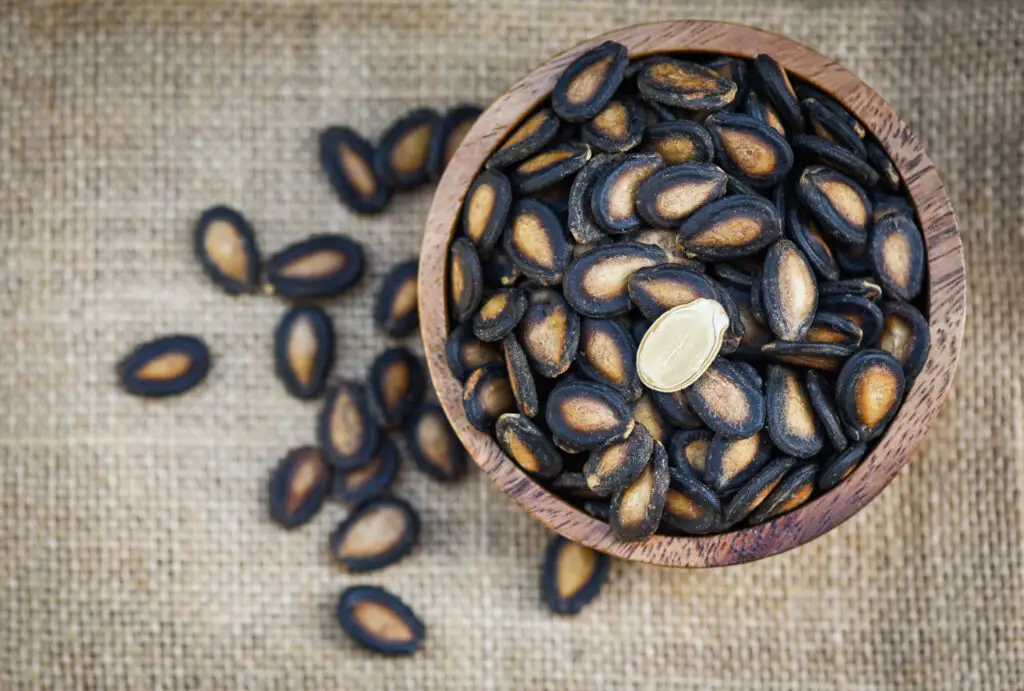
Dua is a traditional Tet food made from melon seeds. The seeds are first soaked in water, and then boiled until they are soft. Next, they are roasted with salt and spices until they turn golden brown. Finally, they are served with a sweet dipping sauce.
Dua is often served during Tet as it is believed to bring good luck.
According to legend, the dish was created by a princess who was imprisoned in a melon by an evil king. When she finally escaped, she decided to share her good fortune by creating dua for everyone to enjoy. Today, dua is still enjoyed as a symbol of luck and prosperity.
Canh Bóng
Canh bóng is a traditional Vietnamese soup that is typically made with root vegetables, mushrooms, pork skin, and cooked in a broth of ginger, pepper, and other spices.
Canh bóng is thought to bring good luck and prosperity.
Dưa Hành (Pickled Onions)
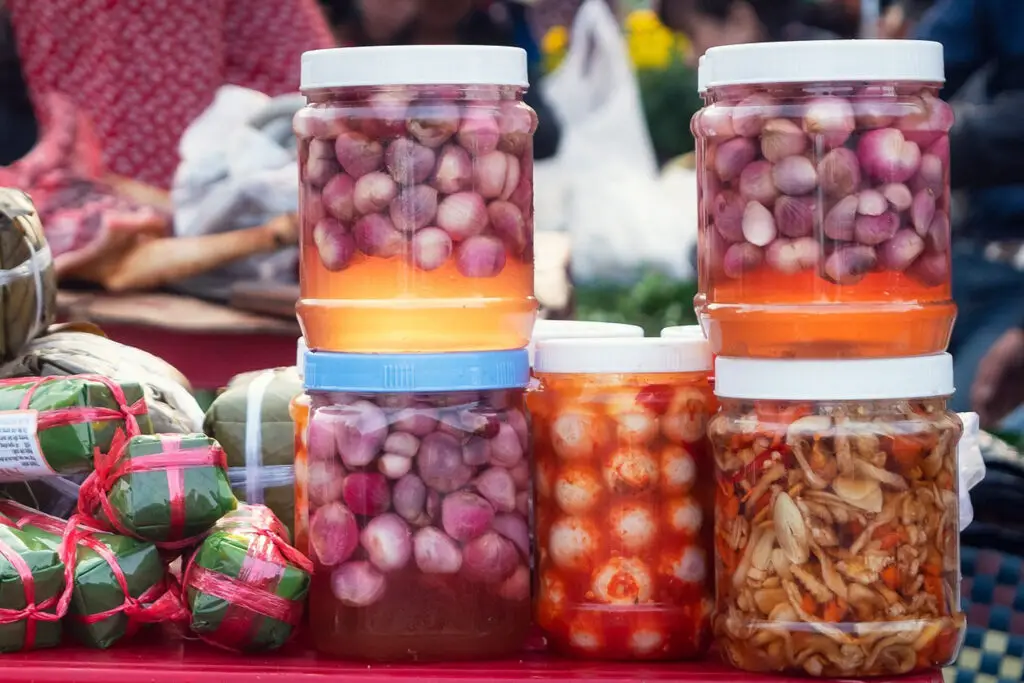
Dưa hành, also known as pickled onions, is another popular Vietnamese New Year dish.
These onions are usually small and white, and they are pickled in a mixture of vinegar, sugar, and salt. This process gives them a sweet and sour flavor that is both refreshing and addictive.
The word dưa means “to sprout,” and hành means “onion.” This dish is symbolic of new beginnings, and it is often served as part of a larger feast to welcome in the New Year.
Chả lụa (Vietnamese Sausage)
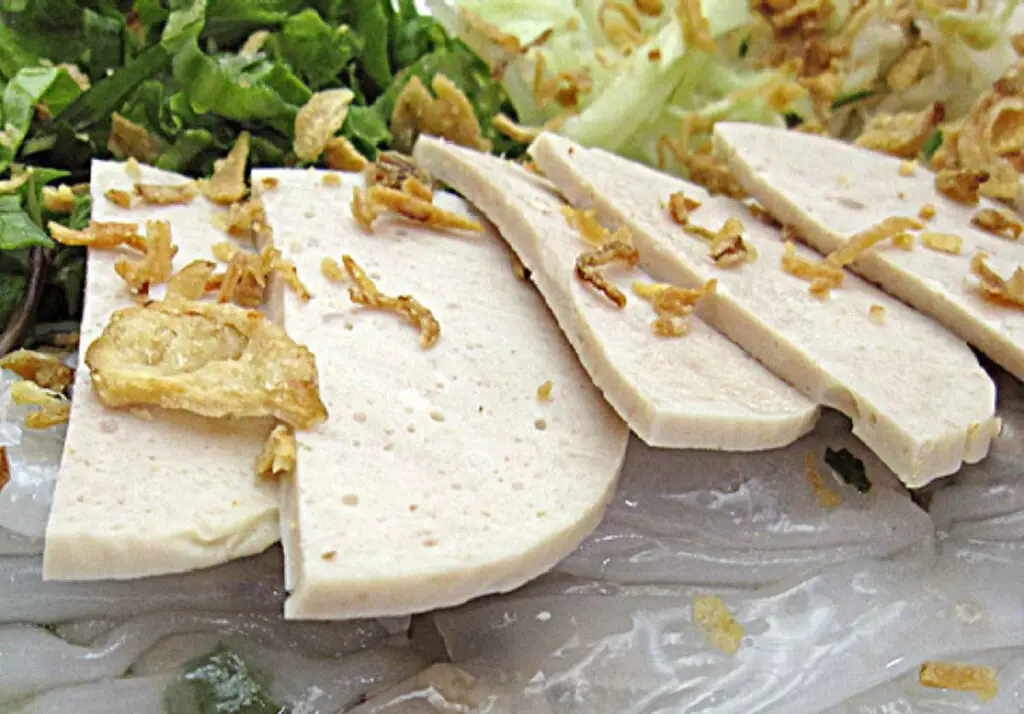
Chả lụa is a type of Vietnamese sausage that is typically made from pork, fish paste, and spices. The sausage is then wrapped in banana leaves or aluminium foil and steamed.
The sausage is thought to represent prosperity and good luck, and it is a symbol of the new year. For many Vietnamese families, Cha Lua is an essential part of the Tet celebration.
Summary of Vietnamese New Year Food (Tet Food)
This is just some of the traditional food eaten by Vietnamese people during the Tet holiday. Whether banh chung, Vietnamese braised pork, candied fruits, roasted melon seeds, or some other traditional food, these Vietnamese dishes are all part and parcel of the Vietnamese culture.
These Tet meals are the most typical food enjoyed by family members during the Vietnamese Tet holiday. Tet is a time to enjoy good food, and good company, and to start the New Year off on the right foot!
FAQs
1. What is Tet?
Tet is the Vietnamese New Year, and it is the most important holiday in Vietnam. Tet occurs on the first day of the first month of the Vietnamese lunar calendar, and it is a time for family reunion, ancestor worship, and thanksgiving.
Tet is also a time for cleansing and renewal, and many Vietnamese people take this opportunity to clean their homes and renew their commitments to their families.
In addition, Tet is a time of hope and good fortune, and many Vietnamese people believe that what they do during Tet will affect their luck for the rest of the year.
As a result, Tet is a time when people strive to be their best selves and to set positive intentions for the coming year.
2. What are some of the traditions of Tet?
The holiday is celebrated with a number of traditional activities, such as decorating homes with lucky symbols, preparing special foods, and visiting family and friends.
In Vietnam, it is also common for people to take part in ancestor worship during Tet. This is done as a way of showing respect for one’s elders and ancestors.
Exchanging Gifts
One of the most important traditions of Tet is the exchange of gifts. This is often done between family members, but it can also be done between friends and co-workers.
The gifts exchanged during Tet are often small but meaningful, such as a box of chocolates or a new outfit. Another tradition of Tet is the giving of money to children. This is done as a way of wishing them good luck in the new year.

